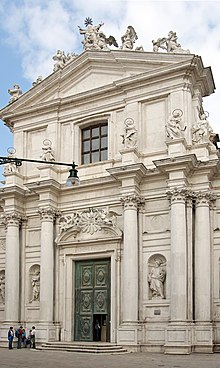I Gesuiti
| Chiesa di Santa Maria Assunta detta I Gesuiti | |
|---|---|

Facade of the church
|
|
| Location | Venice, Veneto |
| Country | Italy |
| Denomination | Catholicism |
| Architecture | |
| Groundbreaking | 1715 |
| Completed | 1729 |
| Administration | |
| Diocese | Patriarch of Venice |
The church of Santa Maria Assunta, known as I Gesuiti, is a religious building in Venice, northern Italy. It is located in the sestiere of Cannaregio, in Campo dei Gesuiti, not far from the Fondamenta Nuove.
According to some sources the construction of the church was financed by a certain Pietro or, according to Doge Andrea Dandolo, by Cleto Gussoni in 1148 and was surrounded by grounds, bodies of water and wetlands. In 1154 Cleto turned it into a hospital for the poor who were ill, both men and women. Another Gussoni, by the name of Buonavere, relative and heir of Cleto, ultimately provided vineyards and some of his other estates in the districts of Chioggia and Pellestrina. In the monastery of I Gesuiti a member of the same family, Marco Gussoni, took his vows, miraculously cured by the then Blessed, later Saint Luigi Gonzaga. It is said that in 1601 Marco, struck down by a grave illness, was healed instantly on the invocation by the saint. However, on 1 August 1631 he contracted the plague and died in Ferrara whilst working to help the plague victims there; he became known as "uomo di somma pietà" (man of supreme mercy). A portrait of him entitled Marco Gussoni blessing the plague victims at the Lazzaretto of Ferrara is exhibited in Ca' Rezzonico.
Saint Ignatius of Loyola visited the city of Venice for the first time in 1523 to embark on a pilgrimage to Jerusalem. He returned to I Gesuiti in 1535 with a group of friends, who already called themselves the Society of Jesus (members of which are referred to as Jesuits - Gesuiti in Italian), and here they were ordained as priests. It took just two years for the group to fully establish themselves in the lagoon of Venice and to gain a large following. They left for Rome in 1537.
In 1606, due to the quarrels between Pope Paul V and Venice, the city was placed under interdiction, and as a consequence, the Jesuits were exiled until 1657. During these years, Venice was involved in a consuming war with the Ottoman Empire and Pope Alexander VIII decided to provide the services of the Betlemitani, an order created to assist the Knights of the Cross who were under the control of this pope.
...
Wikipedia
